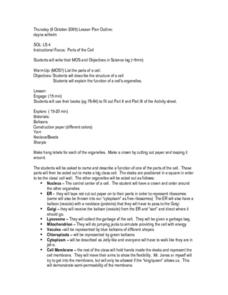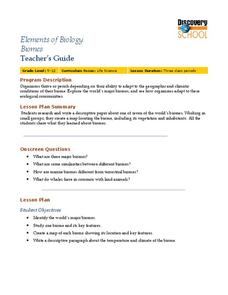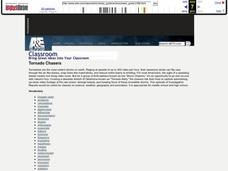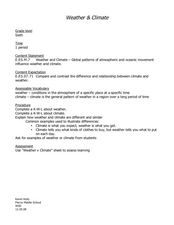Curated OER
Volcanoes And Atmospheres
Pupils identify the volcano as the primary source of atmospheric gases, to explain the formation of ozone, and to recognize the dangers of volcanic gases through the use of technology in the classroom.
Curated OER
Fish Morphology
Students identify the various parts of a fish. They describe the concept of fish morphology and relate shape, form and structure of a fish's parts to function.
Curated OER
Monitoring Aquatic Ecosystems Lesson Plan
Learners perform an experiment to test the quality of the water in a marsh.
Curated OER
Nuclear Waste
Students identify pros and cons of nuclear power, and analyze problems surrounding nuclear waste and how to make decisions regarding its disposal.
Curated OER
Cloning Animals and Plants: Any Difference?
Learners examine the process in which plants and animals are cloned. They compare and contrast the two procedures and determine if there is a difference. They share their views on cloning to the class.
Curated OER
Observation: It's A Natural!
Students play the role of naturalist in their own community just as Thoreau was in his. They observe their communities looking for positive and negative aspects on the environment. They work together in groups to complete a model for...
Curated OER
Parts of the Cell
High schoolers examine plant and animal cells to observe the organelles present in the cell, to match the function of each to the organelle on a cell model and to build a model of the plant or animal cell.
Curated OER
Spineless - YES... Helpless - NO!
Young scholars distinguish between invertebrate and vertebrate organisms while examining the zoological classes of a number of invertebrates. They illustrate a food web of these organisms and investigate the impact of humans on the...
Curated OER
People Are Like Peas in a Pod
Students experiment with peapods to show the diversity of individual within a population. They examine dominant traits, recessive traits, genotypes, and phenotypes and show the process of making a Punnett Square.
Curated OER
Native Knowledge
Students investigate what type of climate and physical features certain Indigenous groups live in using an atlas and a provided worksheet. They then match the tribe and its location to the sustainable stategy employed in agricultural...
Curated OER
Some Like It Hot, Some Like It Cold
Students are explained that thermophiles are organisms that have optimal growth temperatures above 50oC. They investigate the temperature ranges for the growth of common bacteria. Students answer the question of do either of these...
Curated OER
Aerobic vs. Anaerobic Respiration
Learners define aerobic and anaerobic respiration. They compare and contrast the processes of aerobic and anaerobic respiration. Students identify organisms that use the processes of aerobic and anaerobic to synthesize energy from food.
Curated OER
Insect Anatomy
Students explore the anatomy of an insect. In this activity the characteristics of insects, students explore parts of an insect. Students gain knowledge through pictures and charts showing insects and their body parts. Students will...
Curated OER
Biomes
Students explore the worlds biomes and see how organisms adapt to these ecological communities. In this world's biomes lesson students research and write a paper about one of the world's biomes.
Curated OER
Renewable Energy Plants in Your Gas Tank: From Photosynthesis to Ethanol
Students examine the role photosynthesis plays in plant survival. In this renewable energy lesson students document their observations and analyze and interpret their results.
Curated OER
Radioactive Samples
Students examine the different types of radioactivity. In this radioactive samples lesson students complete a lab activity on radiation and complete a handout.
Curated OER
Picture This!
High schoolers compare and contrast different types of light on the electromagnetic spectrum. In this investigative lesson plan students create a photographic image that demonstrates the infrared, ultraviolet and polarization phenomena.
Curated OER
Blue Planet: Coral Seas
Young scholars create a poster about coral reefs. In this oceanography lesson, students teach the class about a given aspect of the coral reefs. Young scholars create posters with images and facts about this habitat.
Curated OER
Tides
Students discover how the position of the Sun, Moon and Earth affect tides. For this science lesson, students view a presentation about the tides. Students discuss the different types of tides.
Curated OER
Algae Experiments
Students describe the characteristics of algae. In this biology lesson, students perform a series of experiment to explore algae. They investigate the basic things algae need to survive.
Curated OER
Tornado Chasers
Pupils explore how tornadoes are the most violent storms on earth. Raging at speeds of up to 300 miles per hour, their awesome winds can flip cars through the air like leaves, snap trees like matchsticks, and reduce entire towns to...
Curated OER
Weather/Climate
Students examine traditional Native American weather/climate knowledge. They keep a weather journal and research cloud cover.
Curated OER
Operation Mexfly
Students research information about pesticides. Students discuss the history of the Mexican fruit fly. They experiment to discover malathion concentration levels in organisms. Students explore the effect of toxins at the top of the...
Curated OER
Human Populations Studies: the Ghost of Populations Past
High schoolers compile data on population distribution and develop survivorship curves using information from cemetery tombstones and obituaries. They develop inferences on the changes in population age distribution in their area over time.
Other popular searches
- Life Skills Worksheet
- Life Skills Math
- Life Skills Lesson Plans
- Real Life Skills
- Math in Daily Life
- Special Education Life Skills
- Basic Life Skills
- Life Skills Lessons
- Nutrition Life Skills
- Plantation Daily Life
- Life Skills Lesson Money
- Computer Budget Life Skills

























